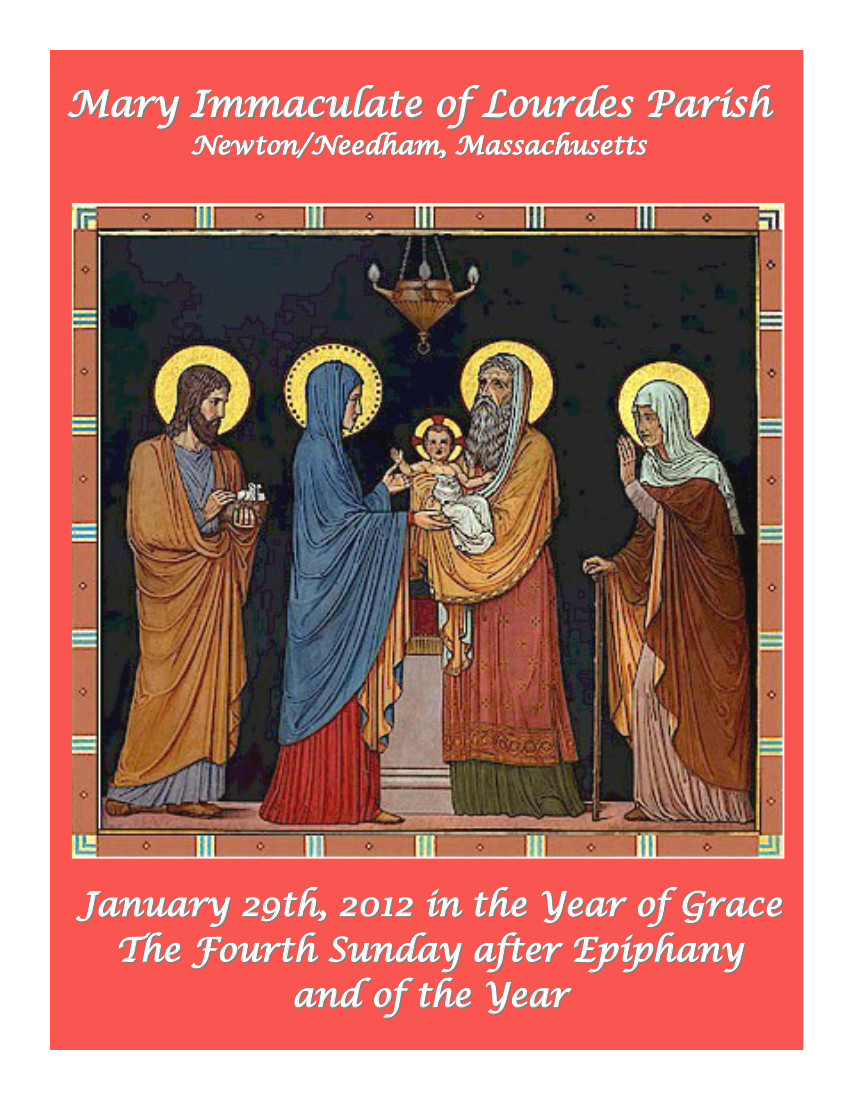
Please visit the Mary Immaculate of Lourdes website and
facebook page for more information.
Mary Immaculate bulletins are available at miol.nu.

Please visit the Mary Immaculate of Lourdes website and
facebook page for more information.
Mary Immaculate bulletins are available at miol.nu.
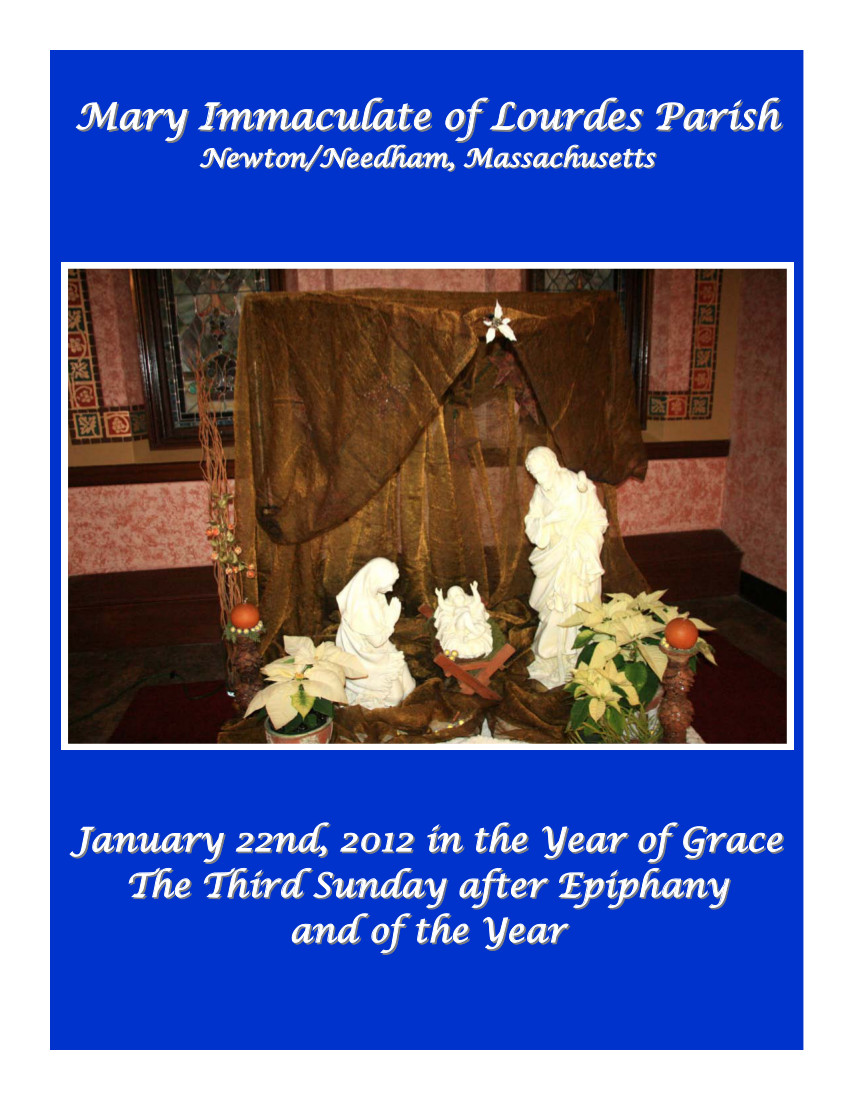
Please visit the Mary Immaculate of Lourdes website and
facebook page for more information.
Mary Immaculate bulletins are available at miol.nu.
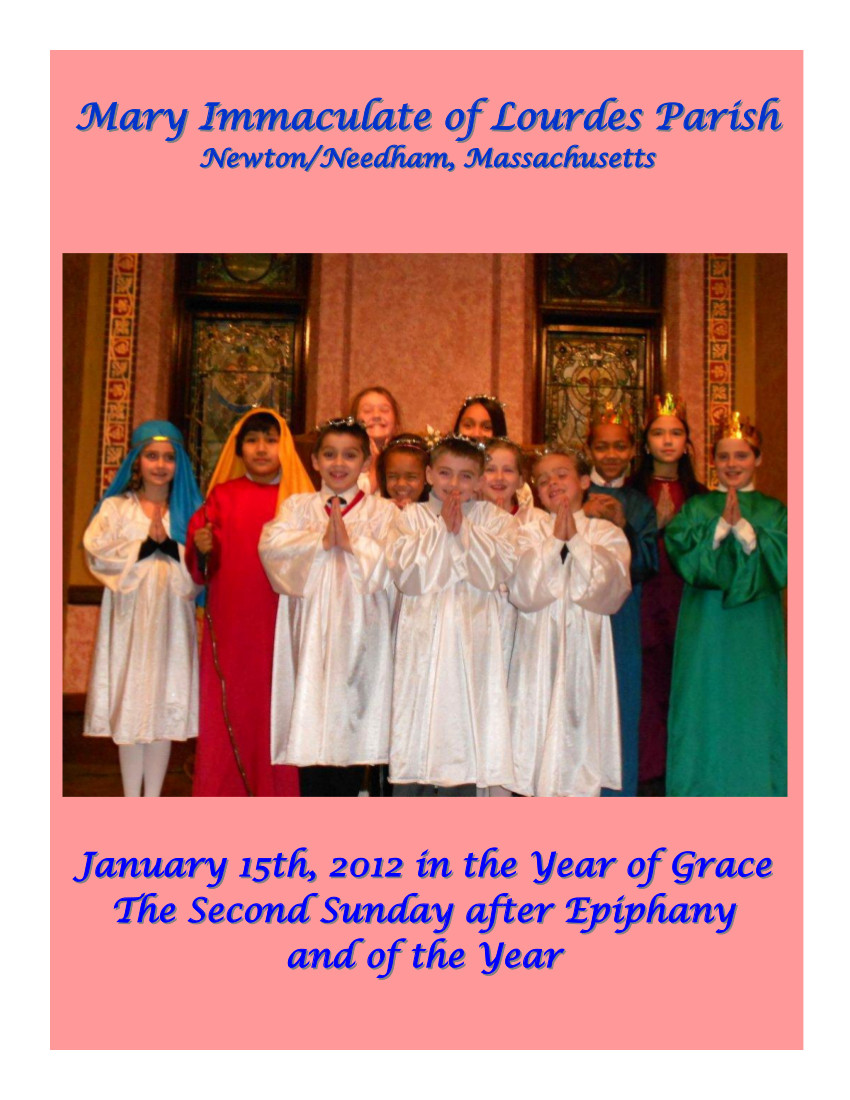
Please visit the Mary Immaculate of Lourdes website and
facebook page for more information.
Mary Immaculate bulletins are available at miol.nu.
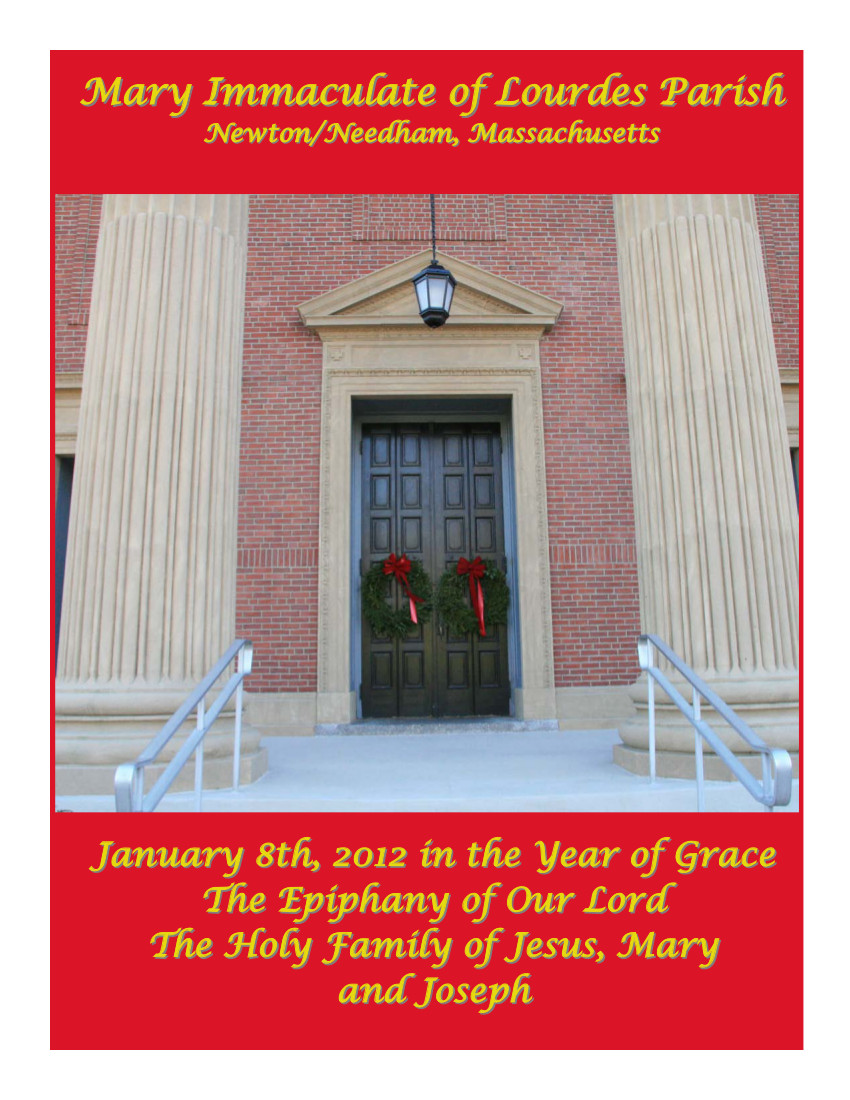
Please visit the Mary Immaculate of Lourdes website and
facebook page for more information.
Mary Immaculate bulletins are available at miol.nu.
Bulletin: MaryImmaculate-2010-08-22.pdf
Pastor’s Note: Maria Regina Mundi
Catechetical Corner: The Feast of the Immaculate Heart of Mary
Please visit the Mary Immaculate of Lourdes website and
facebook page for more information.
Mary Immaculate bulletins are available at miol.nu.
(Pastor’s Note from the Mary Immaculate of Lourdes Bulletin for August 22, 2010)
In the summer of 1991 I was present among the 1 million pilgrims who had converged on the Polish city of Czestochowa for the celebration of World Youth Day with Pope John Paul II. The feast for the World Youth Day Mass with the Pope was the Feast of Our Lady’s Assumption, August 15th.
A most remarkable feature of that World Youth Day was that it was the first of these biennial events after the fall of the Berlin Wall in 1989 and the subsequent implosion of the Communist dictatorships in the “iron-curtain” countries of central and eastern Europe, so there were youth delegations from all of these countries there in significant numbers, identified in the crowds by their national flags and their hand-made banners. I remember my surprise at finding myself next to two Soviet Russian girls in the throng of people greeting the Pope upon his arrival to the city, August 14th. They had very limited English and I had no Russian, but they knew enough to make themselves understood. Communism had done all it could (with massive violence) to stamp out religion, especially Christianity…and here the youth of the Communist societies had come to cheer the Pope, looking to the Gospel of Jesus and not to Marx and Lenin for their inspiration.
One of my most cherished memories is of the all-night vigil that was kept around the monastery of Jasna Gora. The night was overcast and slightly foggy, so it was difficult to see where you were going and exactly what were the surroundings. I remember marching in silence
with the procession of people trying to get closer to the shrine. It was between two and three in the morning of August the 15th.
The number of people who had come to Czestochowa had vastly exceeded both the authorities’ expectations as well as the city’s
capacity to hold them. The open space around the shrine, the roads leading to it, as well as the wooded park-space was jammed with people long before dawn. Yet, despite the crowd there was no disorder. Everything was quiet and hushed. Somewhere in the dark mist could be heard the singing of a Latin refrain:
Maria regina mundi,
Maria regina coeli,
Tibi assumpta, tibi assumpta
Vigilamus, vigilamus.(Mary Queen of the world,
Mary Queen of heaven,
To thee assumed, to thee assumed
We keep vigil.)
Three days after the Pope’s triumphal visit to Czestochowa, the hard-line Communists within the Soviet military staged a coup d’état against the reformist leader Gorbachev, whom they placed under arrest. It looked as if all of the hopes for a peaceful, post-Cold War Europe had been misplaced. Tanks in the streets had shut down the popular aspirations for freedom from Communism as they had so many times before during the Cold War: Berlin, 1953, Hungary, 1956, Prague, 1968. But then, suddenly, the tables turned, the Communist hard-liners had to back down in the face of popular opposition, Gorbachev was released. The day that the coup d’état failed was August 22nd, 1991—the feast of the Queenship of Mary and the old feast of her Immaculate Heart.
THE FEAST OF THE IMMACULATE HEART OF MARY
(From ecclesiastical documents, Divine Office for feast of the Immaculate Heart of Mary, 1962 Breviary. Reproduced from the Mary Immaculate of Lourdes Bulletin for August 22, 2010)
At the beginning of the nineteenth century the Apostolic See first approved the liturgical worship by which the Immaculate Heart of the Virgin Mary is given due honor. The way was prepared for this cult by many holy men and women. Pope Pius VII instituted the feast of the Most Pure Heart of Mary, to be celebrated in a devout and holy way by all the dioceses and religious congregations which had requested it. Later, Pope Pius IX added the proper Office and Mass. But the ardent zeal and hope which had arisen even in the seventeenth century and had grown day by day, that this feast should be given greater solemnity and be extended to the whole Church, was graciously fulfilled by Pope Pius XII in the year 1942, when a terrible war was spreading through almost the whole world. He had pity on the limitless hardships of the people, and because of his devotion and trust in the heavenly Mother, he solemnly commended the whole human race to her most gentle Heart and appointed that a feast with its own Office and Mass be celebrated forever and everywhere in honor of her Immaculate Heart.

The Second Sunday of Advent – This week’s bulletin for Mary Immaculate of Lourdes, Newton:
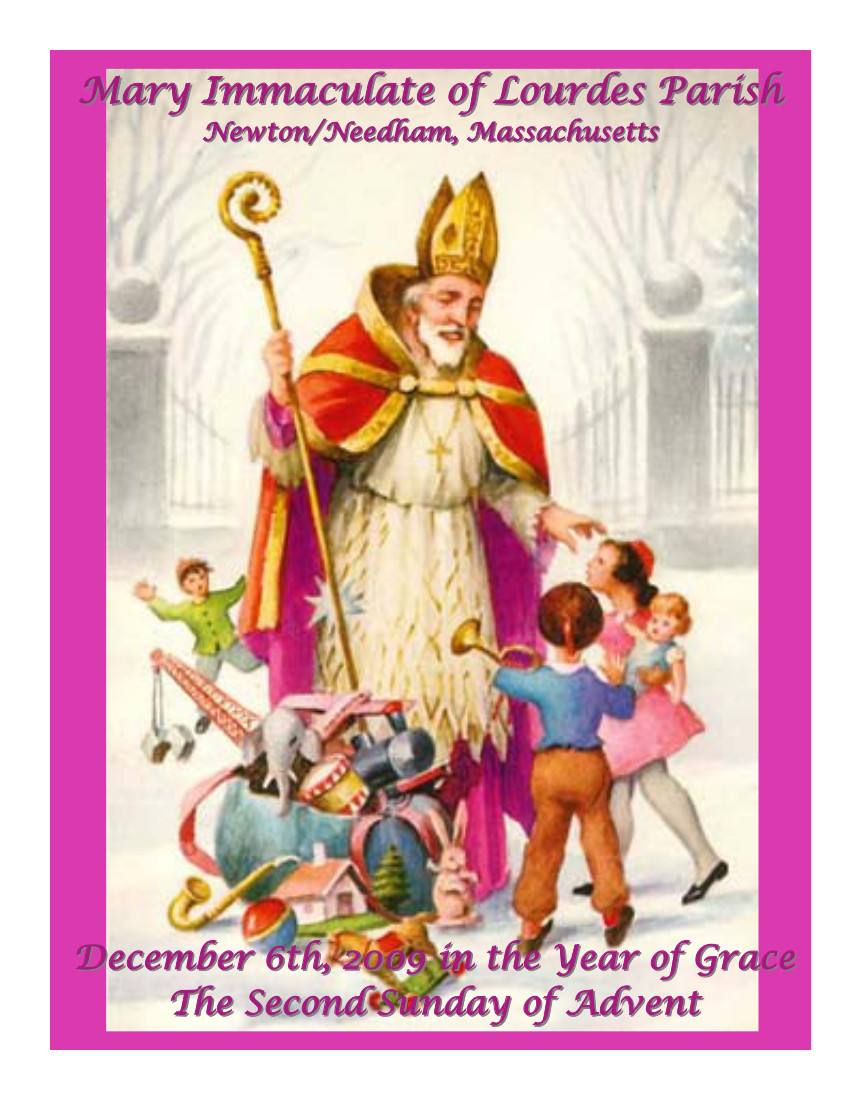
Front Cover: An illustration of St. Nicholas, Bishop and Confessor, bringing gifts for children. St. Nicholas, who lived in the 4th century, is the great saint of charity to the poor and the protector of children. His feast-day—St. Nicholas Day—is December the 6th.
Pastor’s Note: THE PEACE OF CHRIST
Calendar of Masses; Latin Mass Texts; Music Programs for this Sunday’s Masses; Latin Mass Community Announcements; Parish and General Announcements
Catechetical Corner: ADVENT CUSTOMS: ST. NICHOLAS DAY
Please visit the Mary Immaculate of Lourdes website and
facebook page for more information.
Mary Immaculate bulletins are available at miol.nu.
One of the Messianic titles of Our Lord is “Prince of Peace”. Wherever Christ’s spirit reigns there is an atmosphere of true peace. This should be especially true of an individual Christian’s own inner state. No matter what his circumstances he finds himself with peace of heart.
Unfortunately, as we know, this is often not the case. A person can have faith and be staying out of mortal sin, and still be experiencing anxiety, sadness, and various other morbid preoccupations. Partly this is due to the weakness of our human nature. In other part it is aggravated by the inhumanly fast-paced, technology-driven life we lead.
In the “Providence of books” there is one book, in particular, I can highly recommend to people who are seeking to learn how to recover or maintain their peace of heart under adverse conditions. This book was written by a Spanish Jesuit priest, Fr. Narciso Irala, in 1944. Its title in English translation is: Achieving Peace of Heart. It has been recently reprinted by Roman Catholic Books in a hardcover edition and it is also readily available on the used books market.
Fr. Irala himself had experienced a nervous breakdown in his youth and was helped back to mental health by the Jesuit psychologist Fr. Laburu. Not only did he personally benefit from Fr. Laburu’s skill and insight, but he also developed a deep interest in how to devise methods for dealing with human problems. Later on in his life, he spent ten years as a Catholic missionary priest in China and gained an extensive knowledge of Oriental psychology.
One of his key insights is that so much of our mental stress problems come from an imbalance between our subjective inner world and the objective world of reality. The practice of simple, straightforward methods to direct our thoughts to concrete outer reality (for example, focusing the mind on what our senses are perceiving in our immediate environment) has a marvelous effect of relieving us of obsessive thoughts and that tearing-ourselves-apart-inside. He writes:
Although intellectual error brings many to the precipice of evil and disgrace, wanton feelings and emotions are responsible for many more physical tragedies.
To my knowledge this is the best and most generally suitable self-help book that is out there for people who are striving to realize that peace which Christ promises in their personal emotional lives.
Your thoughts are the limit of your activities. No one takes a single step further than his convictions. If you imagine to yourself that you cannot do this or that, you will never do it. “Posse quia posse videntur,” the old Romans used to say. “They can because they think they can.” Aside from the times when you need the ministrations or advice of a professional physician, your six best doctors are sun, water, air, exercise, diet and joy. They are always there waiting for you. They cure your ills and do not cost you a cent.
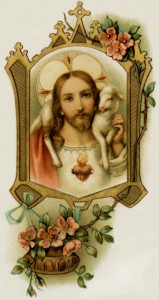
Pastor’s Note from the Mary Immaculate of Lourdes Bulletin for December 6, 2009
ADVENT CUSTOMS: ST. NICHOLAS DAY
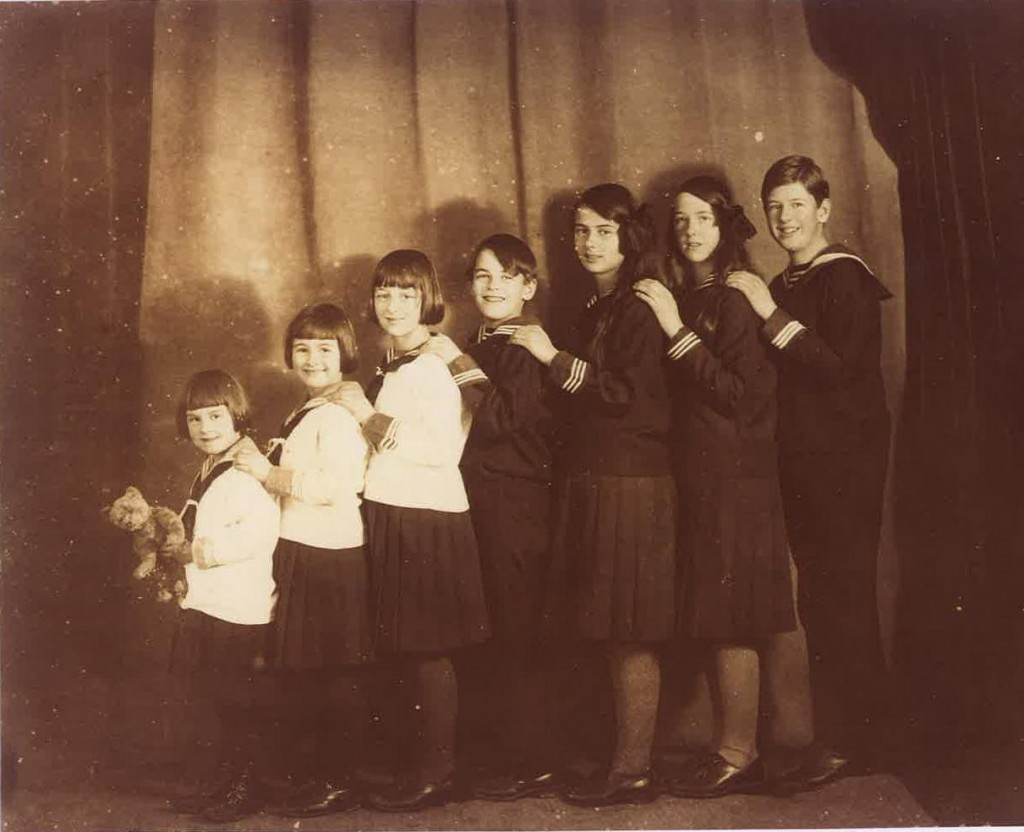
Saint Nikolaus was a saintly bishop of the fourth century, and being always very kind and helpful to children and young people, God granted every year that on his feastday he might come down to the children. He comes dressed in bishop’s vestments, with a mitre on his head and his bishop’s staff in his hand…The excitement was great on [December] the fifth.
Soon after dark we assembled in the hall, looking out through the large window into the driveway…Suddenly one could see the little flicker of candlelight through the bare bushes. A tall figure bearing a lantern and high staff turned into our driveway, followed by a little black fellow [the “Krampus”].
The heavy double-door opened wide, and in came the Holy Bishop, reverently greeted by young and old. The white beard which cascaded down below his waist showed his old age. Nobody could see that half an hour before, it had been plastered on Hans’s face with the help of the white of a raw egg…After he had sat down, he gave the Captain his lantern to hold, and then he produced from under his white cloak a large package with a big golden Cross…In this magic book were written down all the many crimes, big and little, which had been committed by the children of this house. It was quite incredible how well-informed Saint Nikolaus was…
Saint Nikolaus shook his finger and frowned at the sinners as they were called to his feet. They all felt very uncomfortable, and promised fervently to reform. The Holy Bishop rose and waved his hand towards the door; a big sack was pushed in, which Saint Nikolaus opened. There was a bag with fruit and candies for everybody…
(Maria Augusta Trapp: The Story of the Trapp Family Singers, A.D. 1949. Reproduced from the Mary Immaculate of Lourdes Bulletin for June 12, 2009)
N.B. The von Trapp family sang at Holy Trinity, the former home of the Boston area Latin Mass Community.